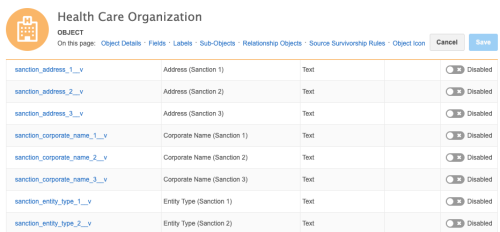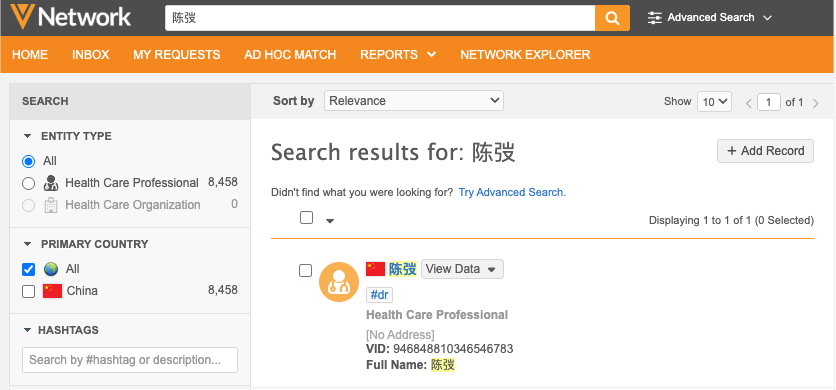Regional data model features
DM
DS
ST
The Network data model includes and allows for additional functionality for selected regions.
Sanctions data (US)
Sanctions data from the United States Office of the Inspector General's List of Excluded Individuals and Entities (OIG LEIE) is available to customers who subscribe to Veeva OpenData for the United States. New fields have been added so that sanctions data can be loaded and viewed. HCP or HCO entities that have sanctions from this governing body will be easily identified within Network. Users and downstream systems can now use this data for their individual corporate business requirements.
Enabling sanctions data fields
A series of fields have been defined for sanctions data. These fields must be enabled so that you can view the data in the entity profile.
To enable sanctions fields:
- In the Admin console, click Data Model > Customer Master Domain.
- Select the Health Care Professional or Health Care Organization object.
- Filter the Fields list for the Country that you want to enable the field for.
- Find the sanctions fields that you want to enable. All of the field names are prefixed with sanctions_.

- To enable the field, in the Status column, toggle the
 Disabled icon. The icon becomes green and is renamed to Enabled.
Disabled icon. The icon becomes green and is renamed to Enabled.
The field displays on the HCP or HCO profile page. Each sanction field is categorized into Sanction 1, Sanction 2, or Sanction 3. A section for each group is created, for example, OIG LEIE Sanction 1. The sanction field that you enable is placed into the respective group.

2-tier and 3-tier hierarchies (China)
Currently, Network instances in China use either a 3-tier hierarchy model or a 2-tier hierarchy model. To enable 2 or 3 tier hierarchy model, contact Veeva Support.
- A 3-tier model is one in which HCPs are affiliated to department HCOs, which in turn are affiliated to hospital HCO entities.
- A 2-tier model is one in which HCPs are directly affiliated to hospitals. This model does not include the departmental level HCO in CRM or Network hierarchical data.
For Network instances that are enabled for a 3-tier hierarchy model, HCO relationships that are not considered relevant are hidden.
The 2/3 tier feature ensures entities will have unique primary relationships for both the 2 and 3 tier hierarchy models.
Searching for Veeva OpenData records in 2-tier and 3-tier hierarchies
When you have the 2-tier or 3-tier hierarchy model enabled in your Network instance and users are searching for Chinese Veeva OpenData records, the affiliation between the HCP and HCO (hospital) is hidden from the search results when Network instances use a 3-tier hierarchy model. Hiding the Parent HCO affiliation between the hospital and HCP simplifies the data and aligns with the standard behavior of 3-tier hierarchies.
This feature applies only to Chinese data when the Search OpenData option is enabled in the General Settings.
Hierarchy models

- 2-tier hierarchy - HCPs are directly affiliated (Parent HCO A) to hospitals. This model does not include the departmental level HCO in Veeva CRM or Network hierarchical data with a Veeva OpenData Subscription and data visibility profile filters on the HCO type Department.
-
3-tier hierarchy - HCPs are affiliated (Parent HCO B) to department HCOs, and department HCOs are affiliated (Parent HCO C) to hospital HCO entities. The affiliation (Parent HCO A) between an HCP and the hospital HCO is hidden.
To ensure that 2-tier customers do not see the department HCO, the HCO type must be filtered from the data visibility profile for users who can search Veeva OpenData for records. For more information, see the Veeva Network Online Help.

4-byte characters
Network supports 4-byte characters used in Chinese and Japanese languages.

Supported activities
-
Data load - Loading 4-byte characters into Network through source subscriptions and the Data Updater.
-
DCRs - Including 4-byte characters on add and change requests.
-
Search - Using 4-byte characters to search for records.
Enable the feature
Support for 4-byte characters is not enabled by default in your Network instance. Contact Veeva Support.